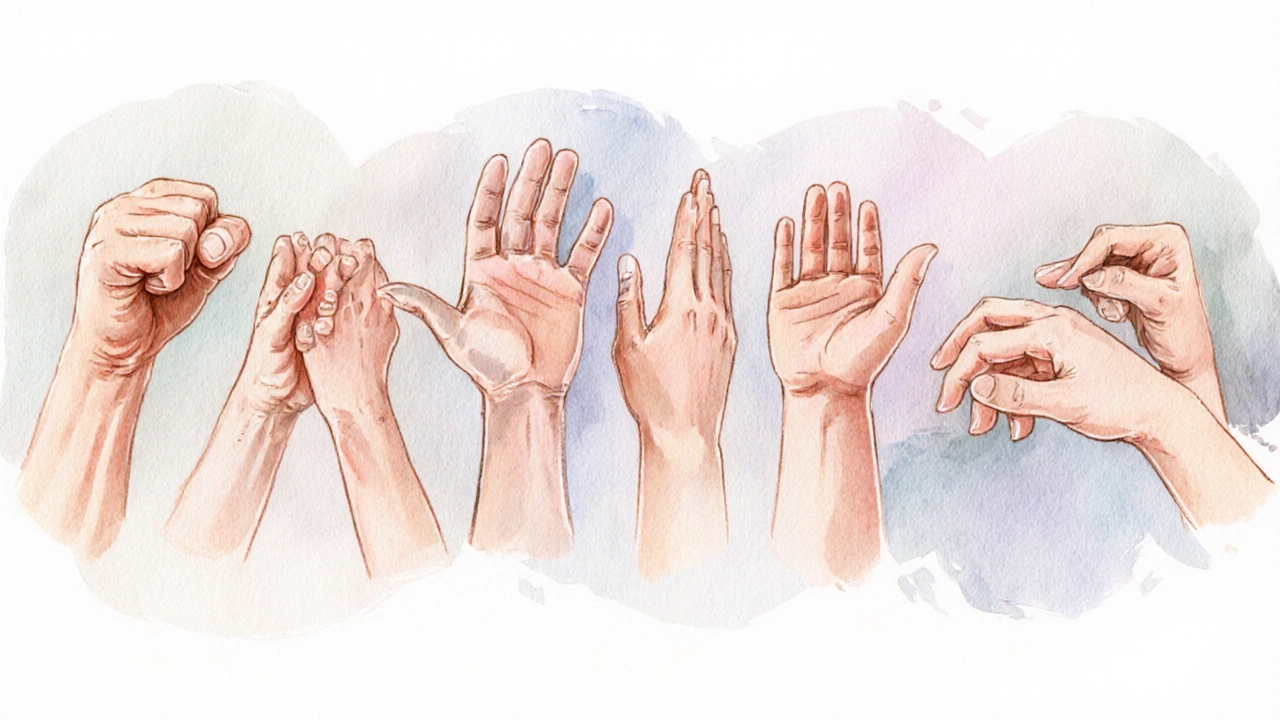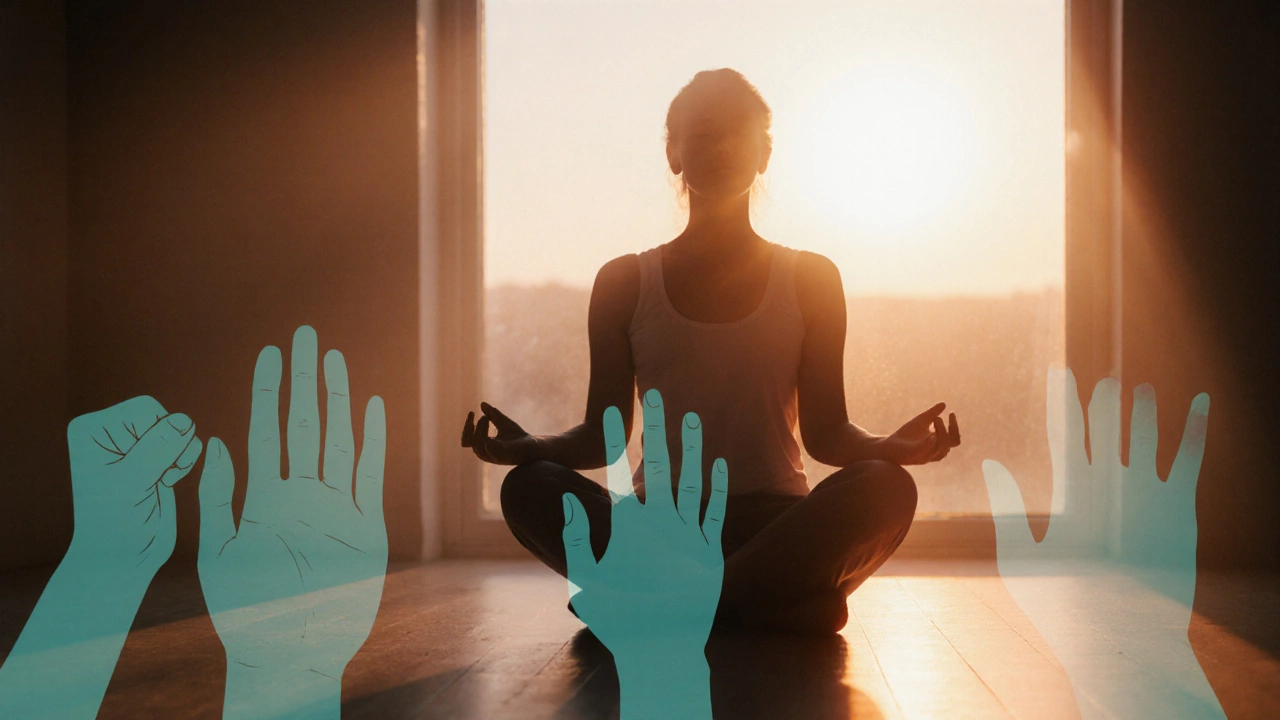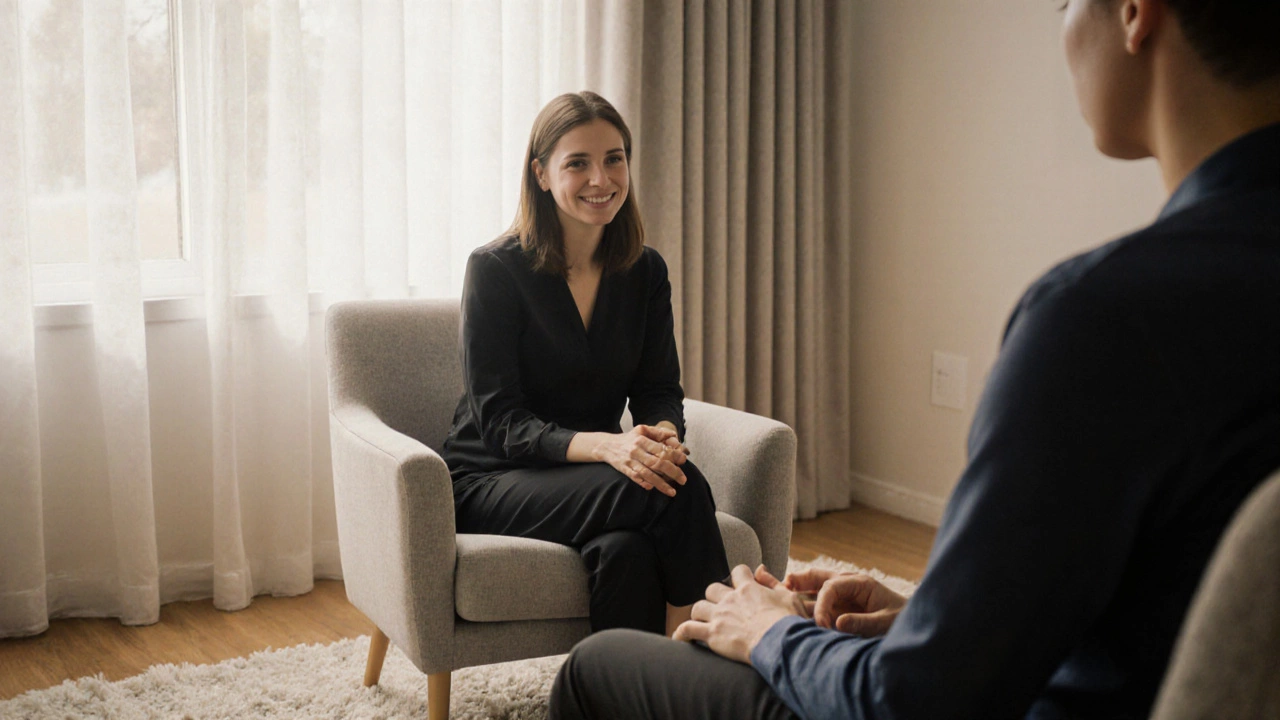Therapy Hand Gesture Quiz
Question 1: What does a clenched fist typically indicate in therapy?
Question 2: What does an open palm facing upward often signal to therapists?
Question 3: What does rapid finger tapping typically indicate?
Question 4: What does crossing arms with hands hidden usually signal?
Question 5: What does self-soothing hand motion (like rubbing arms) typically indicate?
Nonverbal communication in psychotherapy is the subtle language of posture, facial expressions, and especially hand movements that clinicians use to gauge a client’s inner world. When a therapist seems to focus on the way you curl your fingers or fidget with a pen, they’re not being nosy - they’re tapping into a rich source of emotional information that words alone often miss.
Quick Takeaways
- Therapists watch hands to read stress, anxiety, and trauma signals.
- Common gestures include clenched fists, palm up/down, and self‑soothing motions.
- Hand cues help shape interventions in CBT, Gestalt, and trauma‑focused therapies.
- Being aware of your own hand language can speed up the therapeutic alliance.
- Misinterpreting a gesture is possible; always discuss what you notice.
Why Hand Gestures Matter in Therapy
Human beings are wired to communicate nonverbally. Studies from the field of body language show that up to 93% of emotional meaning is conveyed through posture, facial cues, and hand movements. In a therapy room, the client’s verbal story is often accompanied by a parallel, sometimes contradictory, physical story.
Therapists have been trained to notice these contradictions because they can signal resistance, suppressed feelings, or moments of insight. A clenched hand might betray anger that the client claims not to feel; a gentle palm‑up gesture could indicate a readiness to receive support.
Key Hand Gestures Therapists Look For
Below are the most common hand‑related cues and what they typically indicate:
- Clenched fists or tight grip: Heightened tension, potential aggression, or unresolved trauma.
- Open palms facing upward: A subconscious request for connection or help.
- Self‑soothing actions (e.g., rubbing the forearm, twisting a ring): Attempts to calm the nervous system, often seen in anxiety.
- Rapid finger tapping or drumming: Restlessness, nervous energy, or impatience.
- Crossed arms with hands hidden: Defensive posture, withdrawal, or lack of trust.
- Gesturing while speaking: Engaged processing, higher confidence, and clearer articulation of thoughts.

How Hand Observation Fits Into Different Therapeutic Models
Therapists don’t use hand cues in a vacuum. Each therapeutic approach gives the gesture a specific role.
| Approach | Hand‑Gesture Emphasis | Typical Intervention |
|---|---|---|
| Cognitive Behavioral Therapy (CBT) | Identifies tension that contradicts thought records | Introduce relaxation breathing when clenched hands appear |
| Gestalt Therapy | Highlights “unfinished business” through repetitive gestures | Use the “empty chair” technique while the client’s hands mimic the absent person |
| Trauma‑Focused EMDR | Monitors self‑soothing movements that may signal dissociation | Pause bilateral stimulation until the client feels grounded |
| Mindfulness‑Based Therapy | Observes hand placement during body scans | Guide the client to rest hands on the lap, fostering presence |
Notice how each model translates a simple hand cue into a concrete technique. That’s why your therapist’s glance at your hands can lead to a specific, targeted intervention.
Benefits of Hand‑Focused Observation
When a therapist accurately reads your hand language, several therapeutic gains follow:
- Stronger therapeutic alliance: Clients feel truly seen when nonverbal cues are acknowledged.
- Early detection of hidden emotions: Hand tension often appears before the client can verbalize fear.
- More precise interventions: Tailoring grounding or exposure exercises based on real‑time cues improves outcomes.
- Empowers client self‑awareness: Recognizing your own gestures builds emotional regulation skills.

How to Use Your Hand Awareness in Sessions
Being an active participant in the nonverbal dance can speed up progress. Try these practical steps:
- Notice before you speak: Take a brief pause and scan your hands. Are they relaxed or tense?
- Label the feeling: If you notice a clenched fist, silently name it - “I’m feeling angry.”
- Share with your therapist: Simply say, “I’m noticing my hands are tight right now.” This opens a window for deeper exploration.
- Practice grounding gestures: Place both palms flat on your thighs, feel the contact, and breathe. Grounding reduces anxiety spikes that show up as rapid tapping.
- Use visual cues for homework: Keep a small sticky note on your desk that says “Check hands.” When you glance at it, you pause to assess your body state.
Common Misconceptions About Hand Observation
Clients sometimes wonder if the focus on hands is invasive or inaccurate. Here are the myths busted:
| Myth | Reality |
|---|---|
| Therapists are reading my mind. | They are interpreting physical signals, not thoughts. |
| All gestures mean the same thing for everyone. | Cultural background and personal history shape each cue. |
| If I change my hand position, the therapist will stop caring. | Shifts are data points; they help the therapist adapt. |
| My therapist is just looking for a diagnosis. | Observation aims to guide supportive strategies, not label you. |
Frequently Asked Questions
Do all therapists pay attention to hand gestures?
Most clinicians trained in psychotherapy are taught to notice nonverbal cues, but the depth of focus varies with the therapist’s orientation and personal style.
Can I ask my therapist to explain what they see?
Absolutely. Bringing curiosity into the session strengthens the therapeutic alliance and helps you work together on the same page.
What if I’m uncomfortable with the therapist’s focus on my hands?
Share that feeling. A good therapist will explore why the focus feels intrusive and adjust their approach.
Are there cultural differences in hand gestures?
Yes. For example, showing the palm can be a sign of openness in some cultures, while in others it may be considered disrespectful. Therapists take cultural context into account.
How can I practice better hand awareness at home?
Set a timer for a few minutes each day, place your hands on your lap, and notice any tension or movement. Label what you feel and release it with a deep breath.
Understanding why your therapist watches your hands turns a seemingly odd habit into a powerful diagnostic tool. By learning the language of your own gestures, you become a more active partner in your healing journey.
